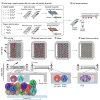[Recent advances in clustered regularly interspaced short palindromic repeats-based detection of severe acute respiratory syndrome coronavirus 2]
- PMID: 36156623
- PMCID: PMC9520371
- DOI: 10.3724/SP.J.1123.2022.08001
[Recent advances in clustered regularly interspaced short palindromic repeats-based detection of severe acute respiratory syndrome coronavirus 2]
Abstract
The rapid global spread of coronavirus disease 2019 (COVID-19), caused by the severe acute respiratory syndrome coronavirus 2 (SARS-CoV-2), has introduced various challenges in global public health systems. The poor applicability and sensitivity of the reverse transcription-quantitative polymerase chain reaction (RT-qPCR) and antigen-based tests, as well as the persistent emergence of SARS-CoV-2 variants with different mutations hinder satisfactory epidemic prevention and control. Therefore, there is an urgent need for diagnostic technologies capable of distinguishing SARS-CoV-2 variants with high sensitivity and low (or no) equipment dependence. Diagnosis based on clustered regularly interspaced short palindromic repeats (CRISPR) has low equipment requirements and is programmable, sensitive, and easy to use. Various nucleic acid detection tools with great clinical potential have been developed for the diagnosis of infectious diseases. Therefore, this review focuses on the reported state-of-the-art CRISPR diagnostic technologies developed for the detection and differentiation of SARS-CoV-2 variants, summarizes their characteristics and provides an outlook for their development.
严重急性呼吸综合征冠状病毒2(SARS-CoV-2)导致的新冠肺炎(COVID-19)迅速蔓延全球,给全球公共卫生系统带来了挑战。由于逆转录-定量聚合酶链反应(RT-qPCR)和抗原测试的普遍适用性和灵敏度较差,并且具有不同突变的SARS-CoV-2变体持续的出现,给疫情防控带来了更大的挑战,因此,高灵敏度、无需设备并且能够区分SARS-CoV-2变体的诊断方法亟须发展。基于成簇的规则间隔短回文重复序列(CRISPR)的诊断对设备要求低,具有可编程性、灵敏性和易用性,已经发展出多种核酸检测工具用于传染病的诊断,其在临床上具有巨大的应用潜力。文章聚焦于近期发表的基于CRISPR实现SARS-CoV-2检测和变体区分的最新技术,总结其特点并对其发展进行了展望。
Keywords: SARS-CoV-2 variants; clustered regularly interspaced short palindromic repeats (CRISPR); isothermal nucleic acid amplification; severe acute respiratory syndrome coronavirus 2 (SARS-CoV-2).
Figures
Similar articles
-
Smartphone-Based SARS-CoV-2 and Variants Detection System using Colorimetric DNAzyme Reaction Triggered by Loop-Mediated Isothermal Amplification (LAMP) with Clustered Regularly Interspaced Short Palindromic Repeats (CRISPR).ACS Nano. 2022 Jul 26;16(7):11300-11314. doi: 10.1021/acsnano.2c04840. Epub 2022 Jun 23. ACS Nano. 2022. PMID: 35735410 Free PMC article.
-
CLEVER assay: A visual and rapid RNA extraction-free detection of SARS-CoV-2 based on CRISPR-Cas integrated RT-LAMP technology.J Appl Microbiol. 2022 Aug;133(2):410-421. doi: 10.1111/jam.15571. Epub 2022 Apr 18. J Appl Microbiol. 2022. PMID: 35396760 Free PMC article.
-
Rapid, Sensitive, and Specific Severe Acute Respiratory Syndrome Coronavirus 2 Detection: A Multicenter Comparison Between Standard Quantitative Reverse-Transcriptase Polymerase Chain Reaction and CRISPR-Based DETECTR.J Infect Dis. 2021 Feb 3;223(2):206-213. doi: 10.1093/infdis/jiaa641. J Infect Dis. 2021. PMID: 33535237 Free PMC article.
-
Development and application of sensitive, specific, and rapid CRISPR-Cas13-based diagnosis.J Med Virol. 2021 Jul;93(7):4198-4204. doi: 10.1002/jmv.26889. Epub 2021 Mar 25. J Med Virol. 2021. PMID: 33599292 Free PMC article. Review.
-
Recent advances in methods for the diagnosis of Corona Virus Disease 2019.J Clin Lab Anal. 2022 Jan;36(1):e24178. doi: 10.1002/jcla.24178. Epub 2021 Dec 17. J Clin Lab Anal. 2022. PMID: 34921443 Free PMC article. Review.
References
-
- Mina M J, Andersen K G. Science, 2021, 371(6525): 126 - PubMed
Publication types
MeSH terms
Substances
Supplementary concepts
LinkOut - more resources
Full Text Sources
Medical
Miscellaneous






